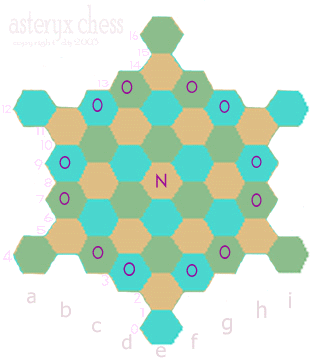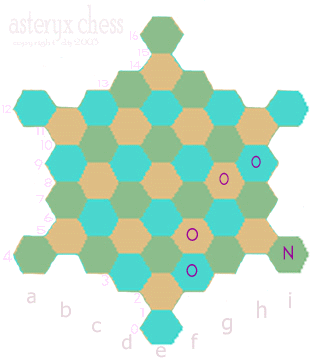Asteryx Chess
DTJagger Copyright 2003. All rights reserved.Introduction
The board is asterisk-shaped (or more like a star of David) and made up of 43 hexagonal cells, coloured symmetrically in 3 colours. All 32 standard chess tokens are used. The start position is as diagrammed. The moves for the various tokens are as illustrated. Generally there is only a basic resemblance to standard chess.
Setup

Rules
Rules of Asteryx Chess:-*1* Object:-
The object is 'checkmate', which is achieved by any of these means:-
by the capture of the enemy king,
by the 'baring' of the enemy king i.e by the elimination of its whole army,
by depriving all enemy tokens of any place to move.
*2* Moves:-
Pawns(P) can move up to 2 spaces forward on any move and may 'snake' or jink within a move, but each element of a move must be forward.

Knights(N) move (in any direction) either two straight onwards plus one more onwards to either side, or one onwards plus two more straight onwards to either side. They will always land on a colour different to their move start colour. Unlike any other token they can leap intervening tokens.


Bishops(B) move in a snaking movement (which comprises two colours of spaces) straight onwards in any direction, any number of spaces. Apart from the basic 'snaking' element there is no curve to their movement.


Rooks(R) move straight onwards in any direction, any number of spaces.

Queens(Q) move as either a bishop or a rook.

Kings(K) move one space only to an immediately adjacent space in any direction.

*3* Promotion:-
Pawns promote (to any piece except a king) on any of the three 'star-point' corner spaces on the opponent's side of the board.
*4* Capture:-
Capture is by 'custodian' capture. Normally within Asteryx this consists in a player coming to occupy (with any of his tokens) at least 2 cells of one colour immediately adjacent to an enemy token. However, where only one cell of a particular colour exists next to an enemy token, occupying that single cell is sufficient to capture the token. A captured token is immediately removed from play.
More than one token may be captured in a single move in the (preferred) 'multiple capture' Asteryx variant. The 'single capture' variant allows only one single token - of the capturer's choice - to be removed whenever there is a 'multiple capture' situation, and is obviously less potentially devastating. Players should initially agree whether they are playing the 'multiple' or 'single capture' variant.
If a capture is not noticed until after the next move has been made, that capture is missed. A player can insist that his own just captured token(s) be removed, provided no further move has been played.
A token may (without being immediately removed) move into a space that is already surrounded by a force sufficient to have performed a capture. A token may only be captured as a result of the current move. A capture position may have to be remade in order to capture an otherwise safe interior token.
*6* Draw:-
A draw occurs on agreement, on the 3rd repetition of a position, or if 30 moves by each side have been taken without a capture.
*7* Otherwise orthodox western chess rules apply, though there is no 'castling' or 'en passant' and kings can 'meet'.
Notes
Design background, thoughts and influences:-This game of 'Asteryx Chess' was inspired by the Chessvariants 43-space competition of 2003 and was created in January/February 2003.
The name 'Asteryx' was chosen because (besides reflecting the board-shape) it seemed suggestive of 'aster' (star) and 'rex' ('king), i.e 'star-king'.
'Asteryx' borrows ideas from several sources, some probably unconscious, but which must include chess, various hexagonal chesses and the old nordic 'tafl' board games. A quick look through my newly acquired Pritchard's 'Encyclopedia of Chess Variants' shows nothing obviously similar - though admittedly he has covered only a fraction of existing variants, and there is likely to be something more closely akin to 'Asteryx' out there somewhere.
I am pleased with how this game turned out, after several doubts along the way whether I would ever arrive at a viable finished product.
I hit on the board shape first as affording an interesting experiment in hexagonal chess which might present its own quirky possibilities. Its central cell ensured against 'mirror' play. The wish to preserve the use of the full set of chess tokens led me rapidly to the starting layout. The bishops being on the same start colour suggested their snaking twi-coloured move (to escape colourboundness). Rook, queen and knight moves were fairly obvious and resisted change. King and pawn moves were decided after some brief flirtations with less attractive alternatives.
What took most time was arriving at the form of capture. Using 'replacement' capture was carnage and not seriously considered. 'Custodian' capture seemed more promising. Earlier efforts tended to lock up the centre of the board if the play was too negative, or just seemed too complex to appeal. My final solution seeks to preserve simplicity and flexibility.
Playtesting turned out to be a delight (mostly), though at every turn I expected to uncover some hideous flaw that would completely invalidate the game. So far so good. Engagement begins immediately, and threats and skirmishes occur throughout the game, which runs to about the same number of moves as usual chess.
I was not too worried about the 'tokens to cells' ratio, though it is at 32/43 much closer to the 3/4 density of checkers(draughts) than the value of 1/2 for chess. The greater possibilities for early exchanges in 'Asteryx', and, too, the need for usually 2 tokens to be involved in a capture, argue for a greater initial density than the norm for a chess variant.
Particularly pleasing is the great variety the game would seem to generate for a comparitively small board. Theoretically it offers (by my count) 1332 different positions after move 1 compared with the 400 of orthodox chess.
The power of the pieces (though variable during a game and always difficult to quantify) is rather different from orthochess. My own rough and ready valuations are:- Q8, B6, R4, N3, (K3), P2.
The game is remarkably lively and, as with standard chess, is a precarious balance of developmental, offensive and defensive exigencies, and which yet offers its own unique world of balletic possibilities.
This is my first published game.
I hope you enjoy it!
Dave J.
Reference:
Check out 'vishangroschessvariants' yahoo group, which includes 'Asteryx'.
